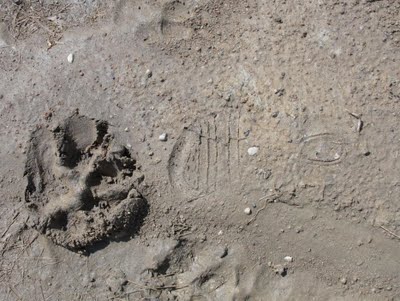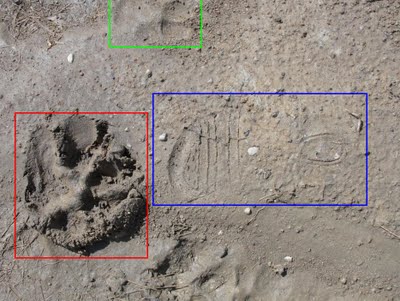Mystery Tracks and CryptoStories
Posted by: Loren Coleman on August 12th, 2009
Various supposed cryptostories have appeared in recent days.
They all are rather, excuse me, lame.
Mystery Track
Take for instance this first one that promotes the following large print found near Janików, Poland. It is said to be of a cryptid (red box) while identifying the one above it as “a large dog’s print” (green box).
What is to say the one that is being labeled so mysteriously is nothing more than a muddy imprint left by the same canid that left the not-so-strange dog track?
Instead of me recycling what seems like a lot of recycled details, you can pick and choose which ones you wish to read further, okay? Most of these stories verge on the bogus or intellectually less-than-stimulating, but I’ll pass these along for mere completeness.
I have lined them up from the “maybe” to the “highly doubtful.” Enjoy, but I warned you.
Supposed Bigfoot Handprint in NC
An Alleged Fossilized Bigfoot Track
About Loren Coleman
Loren Coleman is one of the world’s leading cryptozoologists, some say “the” leading living cryptozoologist. Certainly, he is acknowledged as the current living American researcher and writer who has most popularized cryptozoology in the late 20th and early 21st centuries.
Starting his fieldwork and investigations in 1960, after traveling and trekking extensively in pursuit of cryptozoological mysteries, Coleman began writing to share his experiences in 1969. An honorary member of Ivan T. Sanderson’s Society for the Investigation of the Unexplained in the 1970s, Coleman has been bestowed with similar honorary memberships of the North Idaho College Cryptozoology Club in 1983, and in subsequent years, that of the British Columbia Scientific Cryptozoology Club, CryptoSafari International, and other international organizations. He was also a Life Member and Benefactor of the International Society of Cryptozoology (now-defunct).
Loren Coleman’s daily blog, as a member of the Cryptomundo Team, served as an ongoing avenue of communication for the ever-growing body of cryptozoo news from 2005 through 2013. He returned as an infrequent contributor beginning Halloween week of 2015.
Coleman is the founder in 2003, and current director of the International Cryptozoology Museum in Portland, Maine.












Is that picture of the Qinhai Lake Monster (#2 on the Top 5 Lake Monsters Of China List) for real??? The on eon the top.
I guess not. Probably an artist’s depiction. Thanks for the post.
I *could* be mistaken, but I think there’s a reasonable chance that that print in the blue box is made by a shoe. A shoe is a kind of technical device sometimes worn by Homo sapiens as a form of body covering. It can be used for protection or warmth, etc.
🙂
Seriously – the shape of the half-a-print we can see in the green box looks quite square and similar to the Tasmanian devil.
My question: why only half a print? Was the photographer trying to document the huge dog print (red box) and then someone noticed the half-print in the picture?
On re-reading your post I see that it was thought the top print (green box) is a dog’s while the large one (red) is a mystery animal. The plantar pad in the red box does have a cat-like shape to it, but the digit positions look good for a dog.
Another question: why so muddy? Did the animal bring the mud with it from a nearby creek bed or riverbank? If so, are there not more prints? If not, how was this print made? The red box print looks fresher than the others, but if the red box print was made in wet mud then the other prints should be newer because they’re clearly made when the ground was drier.
All a bit confusing. Need to see more of the context of the prints, and understand more of the weather history.
I personally think that the shoe print is from a child’s sandal – I have young children and that was my initial thought that it looks like a toddler’s sandal print. With no measuring device or something to compare it to – I would just say it’s a normal dog print.